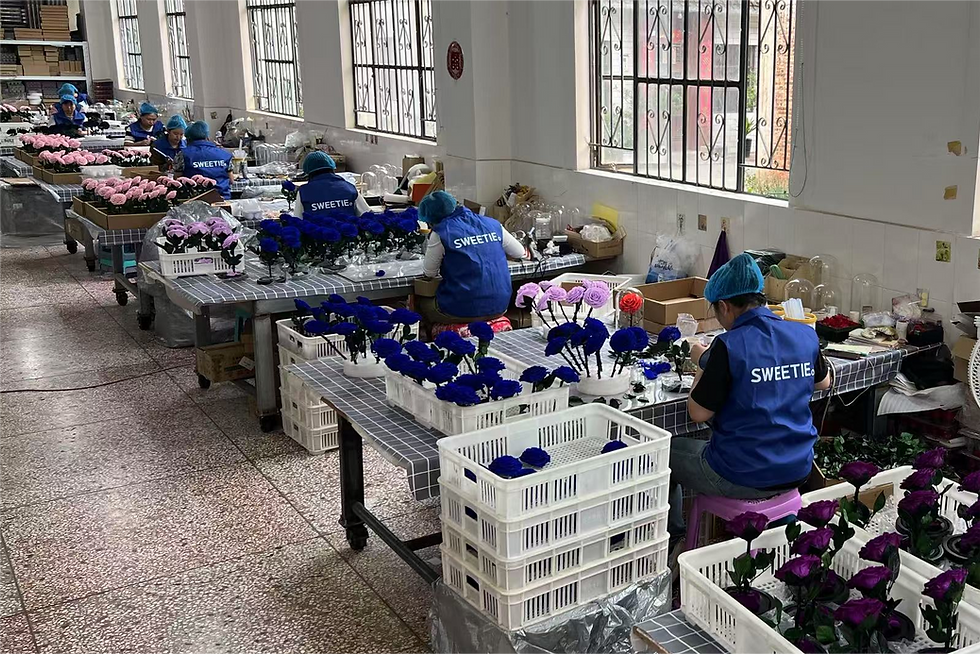The History of Preserved Flowers: From French Innovation to Yunnan Manufacturing Excellence
- Annie Zhang

- Oct 24
- 4 min read

Few inventions have changed the flower industry as quietly—and as completely—as the preserved flower.It began not with a product idea, but with a question: Could a real bloom stay soft and colorful long after it was cut?
That question led to a series of breakthroughs—first in France, where the chemistry was discovered; then in Japan, where the craft became an art form; and finally in Yunnan, China, where preservation turned into a scalable, export-ready business.This is how the technology, design, and production of preserved flowers evolved step by step into the global industry we know today.
Index:
Stage of Development | Key Innovation | Result |
France (1980s–1990s) | Chemical stabilization | Long-lasting, lifelike flowers |
Japan (1990s–2000s) | Design and retail adaptation | Consumer acceptance & gifting culture |
Global supply chain (2000s–2010s) | Sourcing from Andes & Africa | Scalable raw materials |
Yunnan, China (2010s–2020s) | Process standardization & industrial scale | Global manufacturing hub |
1. The French Breakthrough: Turning Art into Science
In the late 1980s, French florists and chemists were searching for a way to capture the freshness of natural blooms beyond the limits of drying or pressing.Their solution was both simple and revolutionary: remove the flower’s natural moisture, then replace it with a carefully balanced blend of alcohols, glycerin, and color stabilizers.
This process—known as stabilization—allowed petals to retain their original texture and vibrancy for years. Unlike dried flowers, preserved blooms remained flexible and lifelike.
By 1988, Verdissimo in Paris had industrialized the technique, creating preserved roses, hydrangeas, and foliage for high-end interiors and displays.
In 1991, Vermont patented a version of the process, setting the scientific foundation for what would become a new floral category.
The key transformation here was control: for the first time, preservation wasn’t about “keeping flowers from dying,” but about managing how they age.

2. Japan’s Contribution: From Technology to Lifestyle
During the 1990s, Japanese florists encountered preserved flowers at European trade shows and saw an opportunity beyond science.Where the French focused on chemistry, the Japanese focused on presentation.
They refined the coloring process, introduced new hues that matched seasonal gift trends, and designed compact packaging suitable for department stores and wedding markets.Preserved flowers in Japan became not just long-lasting blooms, but emotional gifts—symbols of care and craftsmanship.
By 2003, Ohchi Nursery (Daichi Farm) achieved stable domestic production, while Florever set up operations in Colombia to secure high-quality roses from Andean farms.This stage marked the second major shift: commercialization.Preserved flowers were no longer an experiment or luxury novelty—they became a recognizable product with consumer demand and retail value.
If your brand also bridges art and commerce, our team at Sweetie understands how design and manufacturing can work together. Contact us at sales@sweetie-group.com to collaborate on your next floral line.
3. Global Expansion: Building a Supply Chain for Durability
Once demand grew, the industry needed scale.The best raw material turned out to be roses from high-altitude regions like Ecuador and Colombia. Their slow growth and thick petals made them ideal for preservation.
By the early 2000s, preserved-flower production spread along this new axis:
France and Spain led formulation research.
Japan shaped product aesthetics and retail packaging.
Ecuador, Colombia, and Kenya supplied raw roses and foliage.
Each region contributed a piece of the puzzle. Together they formed a global network capable of supporting consistent volume and quality.In 2015, the Innovaflora Group combined several of these players—Verdissimo, Florever, and Latin American partners—into one multinational company.
The third transformation was integration: preserved flowers became a globalized product with shared standards, traceable sourcing, and repeatable quality.

4. Yunnan’s Rise: Scaling Art into Industry
While Europe and Japan led innovation, manufacturing scale eventually found its home in Yunnan, China.Yunnan already supplied a large portion of Asia’s fresh-cut flowers, supported by ideal elevation, mild climate, and logistics infrastructure centered around the Dounan Flower Market—the largest in Asia.
In the 2010s, Japanese technicians partnered with local producers to transfer stabilization know-how. Chinese engineers then adapted the process for industrial efficiency: improving dehydration equipment, refining color-fixing chemistry, and developing eco-friendly packaging for export.
By 2025, Yunnan issued the Provincial Technical Standards for Preserved Flower Processing (DB53/T 1348)—a formal recognition that preservation had become a standardized, high-tech manufacturing field.
At this stage, the evolution completed its final shift: industrialization.The craft that began in a French lab could now meet the demands of global retail chains, e-commerce platforms, and luxury collaborations—all without losing its artistry.
Sweetie-Gifts grew out of this environment, combining Yunnan’s flower resources with over sixteen years of production experience.Today we work with global clients who expect not only beautiful flowers but supply-chain reliability, proofing speed, and packaging precision.
5. What the Journey Reveals
Looking back, the history of preserved flowers is really a story of collaboration:
Science gave the industry its foundation.
Design made it desirable.
Manufacturing made it accessible.
Together, they turned a fleeting natural beauty into a lasting global product.For buyers, that journey also explains why sourcing matters: the best preserved roses today carry not just color and softness, but decades of refinement behind them.
If your team is exploring a new preserved-flower product line, we’d be glad to share technical insights and sampling options. Reach us at sales@sweetie-group.com.

Conclusion
From France’s chemical experiments to Japan’s design evolution and Yunnan’s manufacturing excellence, preserved flowers have moved through four clear stages of growth: innovation, commercialization, integration, and industrialization.
That evolution mirrors the best of global cooperation—where creativity meets precision, and local expertise meets worldwide demand. At Sweetie-Gifts, we continue that tradition every day, helping brands and retailers bring lasting natural beauty to market with confidence and consistency.
Interested in learning more or developing your own preserved-flower concept? Contact sales@sweetie-group.com to start the conversation.
Warm Regards,
CEO of Sweetie-Group









Comments